Our recommendations are made independently. We may receive commissions from purchases made via our links.
How to Dry Basil
Fresh basil will only last a week at most. But once it’s dried, you can keep it around for years. Here’s how to dry basil for those that are interested.
Basil is an essential summer herb to keep in the kitchen. Its unique earthy taste can enhance the flavor profile of any dish.
Unfortunately, basil doesn’t last very long. That is the reason why it’s so helpful to know how to dry basil. Once dried out, basil leaves can last 2 to 3 years.
This guide has all of the information you will need about the process.
Why Should You Dry Basil?
As great a herb as basil is, it doesn’t last very long. Once harvested, a bouquet of basil will begin to wilt in a week’s time. There are two ways you can counteract its short shelf-life: freezing or drying.
Frozen basil will last 3 to 4 months on average. Though that’s relatively long, you will have to keep the basil in the freezer at all times. It’s not quite ideal.
On the other hand, dried basil will remain usable for up to 3 years. As long as you store the dried-out leaves somewhere cool and dry (like a cupboard), it won’t spoil.
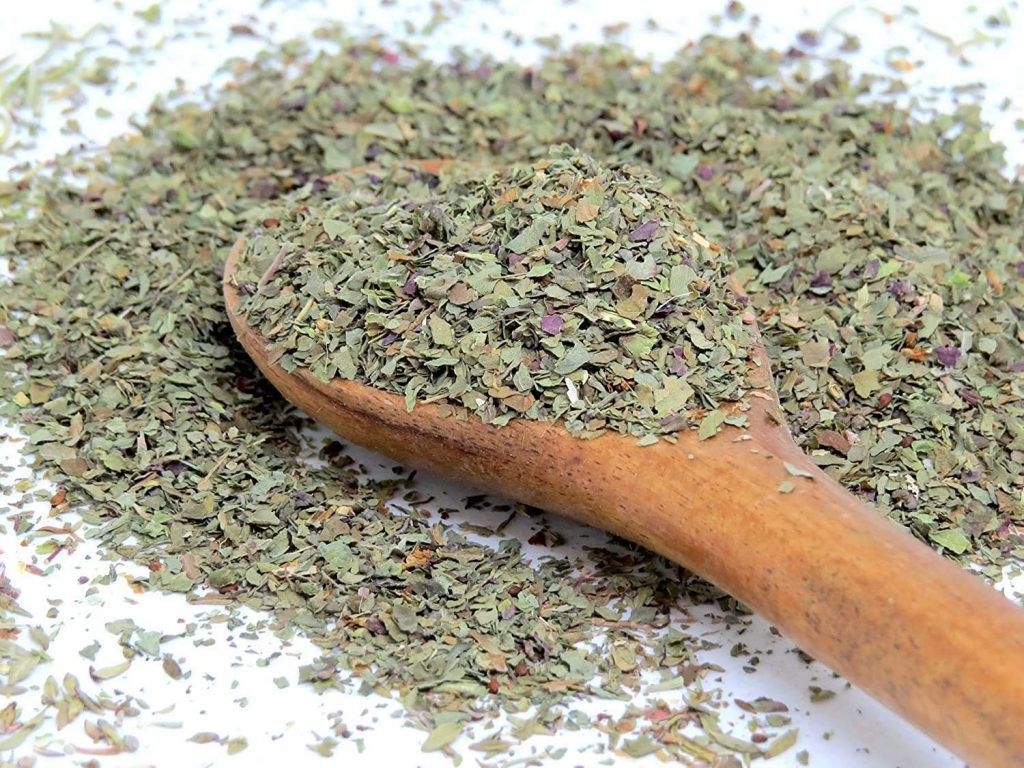
Will the Flavor of the Basil Be Affected?
The answer is yes, but in a good way. The flavor of dried basil is much stronger than that of fresh basil.
There are many different reasons for the difference between dry and fresh basil leaves. The most notable comes from the lost water content of dry basil.
Fresh basil leaves still contain a lot of water. As a result, the chemicals that make up its taste profile are fairly diluted. Drying the leaves, obviously, means extracting nearly all of their water content. The flavoring chemicals thus become more pronounced, making dry basil leaves significantly more pungent than their fresh counterparts.
However, you will also notice that dry basil leaves have a distinctly different flavor than fresh. Specifically, they will taste mintier with a less noticeable note of anise.
The culprit behind this “flavor transformation” is the drying process itself. Heat produced during drying can vaporize some of the oils inside the leaves. This changes not only the taste but also the aroma of the leaves.
Therefore, dried basil and fresh basil are — technically — two different kinds of flavoring herbs. They may share a few similarities, but the taste profile and intensity are quite different.
Keep this in mind before you add either of them into a dish.
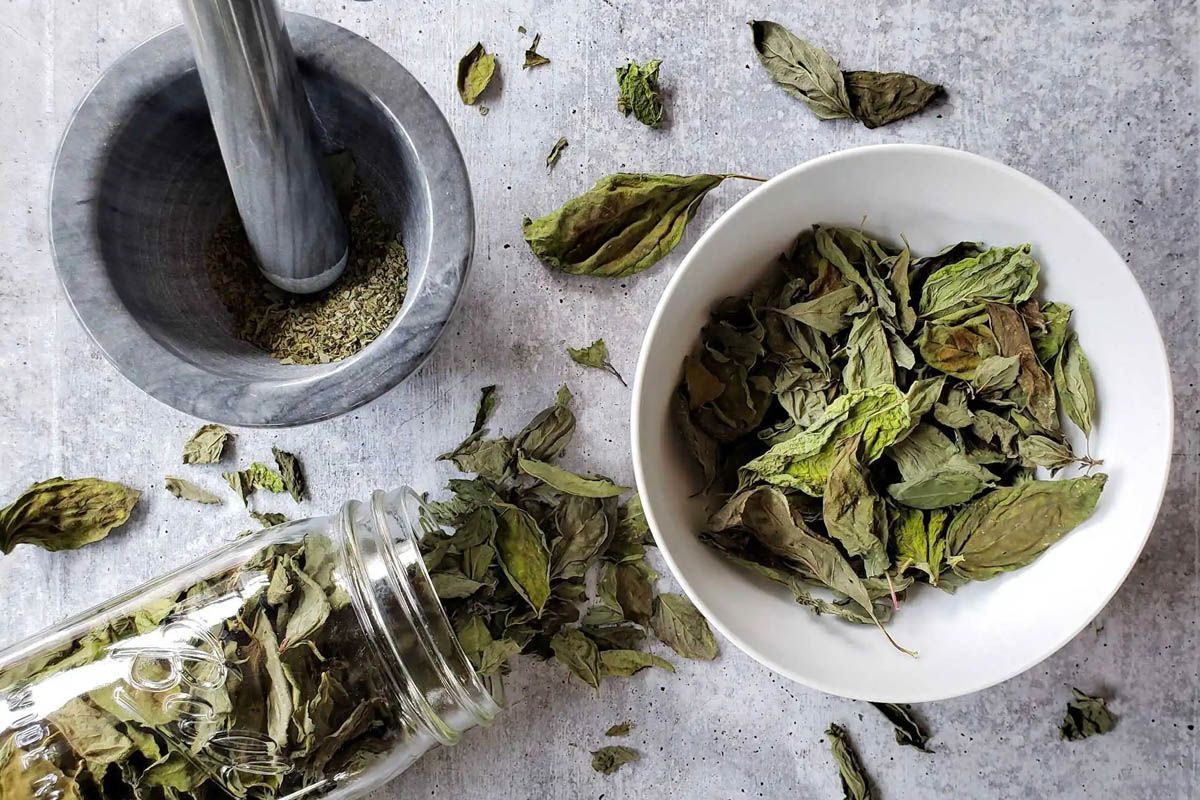
How to Substitute Dry Basil for Fresh Basil
It is possible to substitute dry basil for fresh basil, with a few caveats.
Since dry basil is much stronger than fresh basil, you have to be more conservative when you add it into a recipe. Specifically, if you use dry basil, add only ⅓ the amount you’d use if it were fresh.
For example, if the recipe calls for a tablespoon of fresh basil, you can substitute it with ⅓ tablespoon (1 teaspoon) of dry basil.
How to Dry Basil Leaves
2. In the Oven
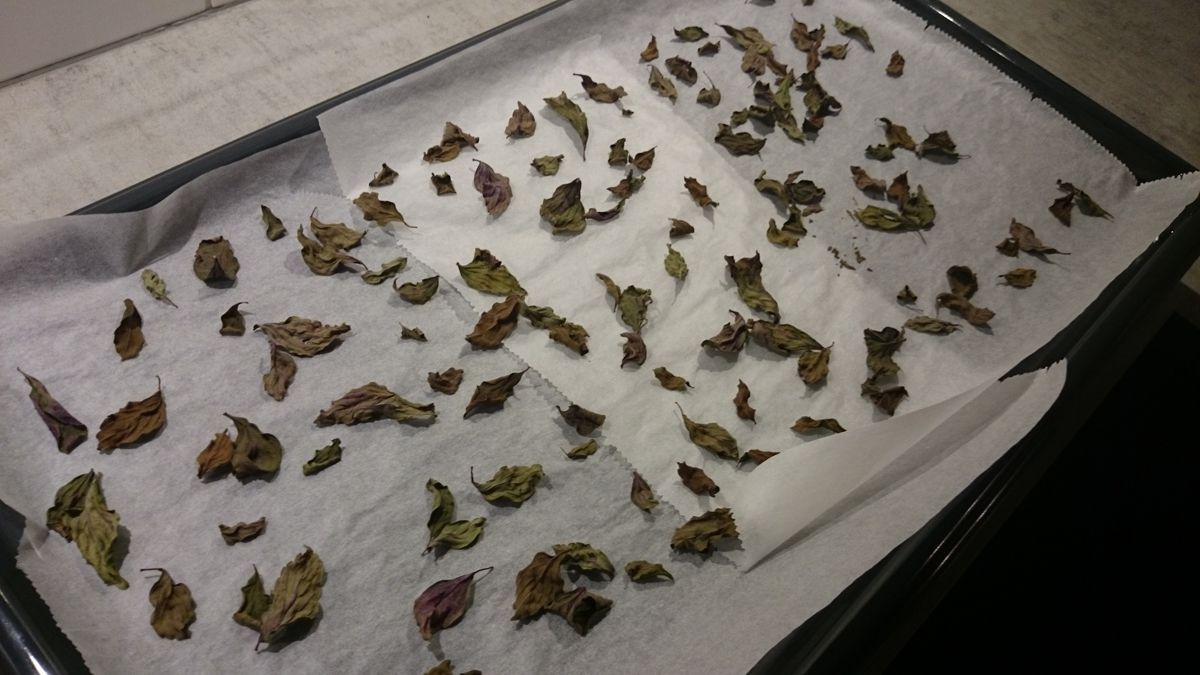
Drying basil leaves in the oven, while simple, can be relatively risky. Because you will be “cooking” the basil for well over an hour, there’s a chance that the leaves will burn. As a result, you will have to keep a close eye on the leaves during the drying process.
The first thing to do is to prepare the basil.
Wash the basil plant carefully in the sink, then dry completely. We recommend leaving it wrapped up in a dry towel overnight. By the time you’re done, you want every hint of moisture on the plant’s exterior to have been eliminated.
Next, preheat your oven to the lowest temperature available. Usually, it will be between 170°F and 200°F.
Ovens that can maintain 170°F to 180°F are excellent for drying. However, if your model only offers 200°F, pay extra close attention to the leaves as they dry, lest they burn.
As the oven warms itself up, arrange the basil leaves in a single layer on a baking sheet. You want them to not touch one another on the sheet. The more space there is between them, the more efficient the drying process will be thanks to increased airflow.
Once the oven is up to temperature, put the baking sheet in. Bake for 45 minutes to an hour. From the 45-minute mark onward, supervise the drying process closely through the oven’s window. When the leaves are sufficiently dried, shut down the oven and bring them out.
Properly dried, they should be very brittle. Test them by squeezing a leaf; if it easily breaks apart in your palm, the batch is ready.
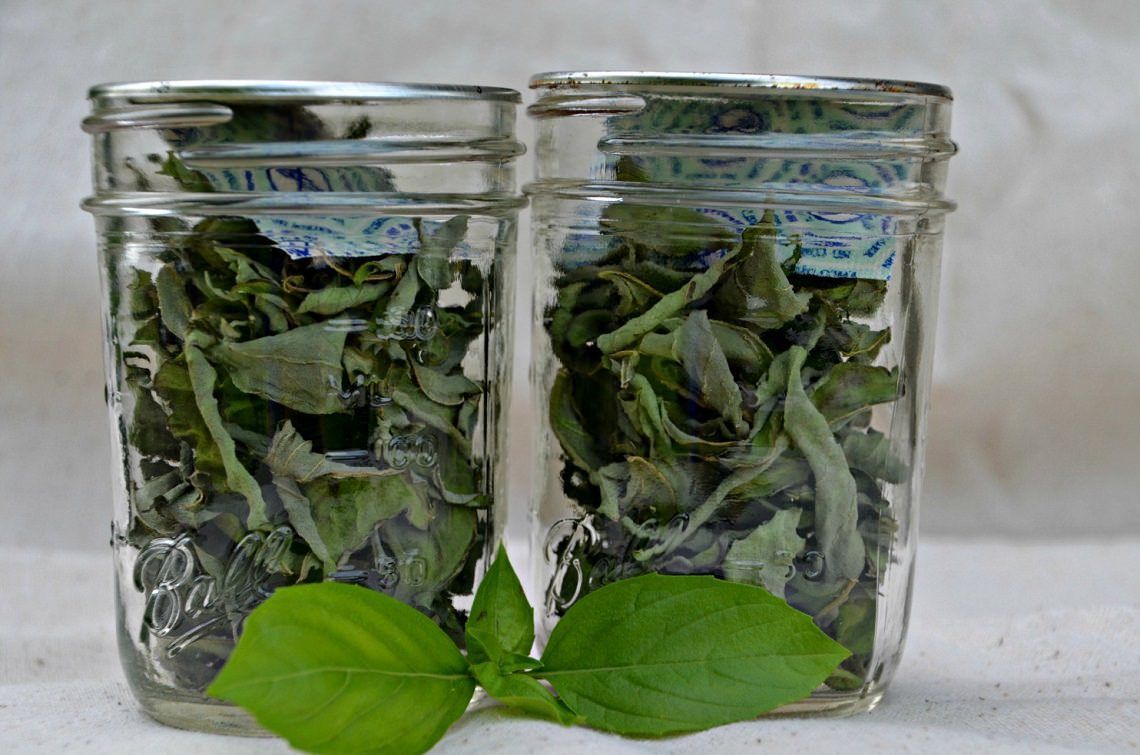
Gather the dried leaves into a bowl and crumble them into smaller pieces with your hands. You can also use a mortar and pestle to make the work easier.
Put the basil bits into glass jars and store somewhere cool, dry, and away from direct sunlight.
What Else Can You Dry With This Method?
Besides basil, many other herbs and produce can be dried using the oven.
It is one of the best ways to dry parsley. Herbs with Mediterranean origins can also be dried pretty effectively with the oven. We have step-by-step instructions on how to use the oven to dry oregano as well as how to dry rosemary.
As for other things, you can dry orange slices with the oven. The oven can also be used to dry cranberries to great results.
2. In the Microwave
Prepare and wash your basil plant as instructed above.
In order to dry basil leaves in the microwave, you have to use a heating technique called “burst heating.” Essentially, you will be zapping the leaves in short intervals, only stopping when they have sufficiently dried out.
Take out a microwave-safe plate and line it with a piece of paper towel. Put your fresh basil leaves on top.
Throw the ensemble into the microwave.
Cook at the lowest power setting for 45 seconds.
After that, reduce the timer down to 30 seconds. Heat in successive bursts of 30 seconds until the leaves begin to shrivel up.
After that, reduce the timer down to 10 seconds. Keep heating in 10-second bursts until the leaves are sufficiently dried.
Take the plate of basil leaves out of the microwave and leave on the countertop. Letting them cool down to room temperature will make them crisper.
Grind up the leaves and put them into a glass jar for safe storage.
What Else Can I Dry With This Method?
Microwave is also a fairly versatile dryer. You can use it to dry peppers. Many herbs can also be dried to acceptable quality in the oven. Namely, it is one of the methods to dry thyme. You can dry cilantro by zapping it in the microwave, too.
3. In a Dehydrator
Though not everyone has a dehydrator at home, it is the simplest and safest way to dry basil.
After washing and drying the basil, pluck the leaves from the plant. Arrange them on the dehydrating screen so that there is plenty of space between them. The more space there is between leaves, the more efficient the airflow and thus the drying process.
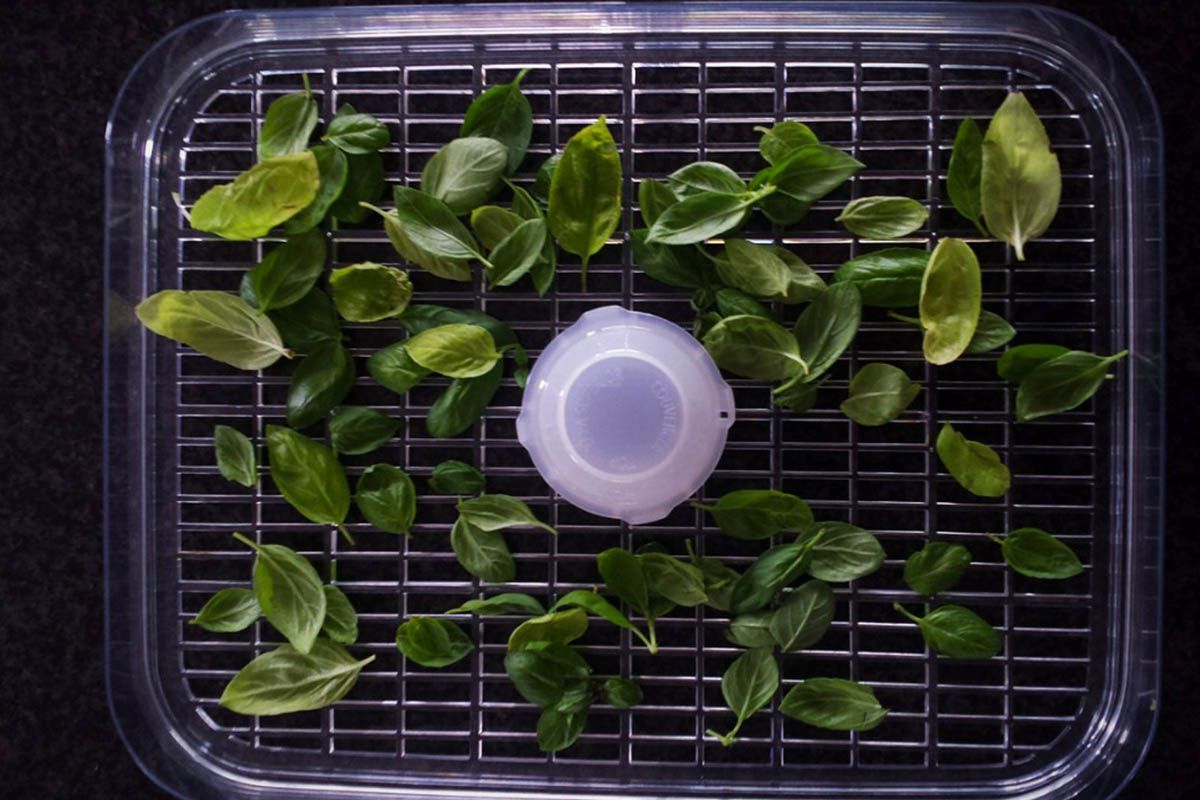
Dry the leaves using the “Herb” setting. If there isn’t such a setting on your dehydrator, select the lowest mode or temperature (usually around 95°F).
The dehydrator may need as long as 12 to 24 hours to work its magic. Its speed will depend a lot on the humidity in your house. The higher the humidity, the longer the process is going to be.
If your house has low humidity, check on the basil leaves at around 6 hours (don’t expect a lot, however). Conversely, if humidity is high around the house, wait 24 hours.
When the leaves are dried out, crush and store in a glass jar as normal.
What Else Can I Dry With This Method?
Because it is specially-built to dry food, anything can be dried in the dehydrator. It can be used to dry dill. If you like to put dried mint leaves into your tea, this machine can dry mint very well, too.
Last but not least, it is the preferred method for drying mushrooms. Mushrooms are fairly sensitive, so drying in the dehydrator is safer and will give you a better result.
Conclusion
And that’s how to dry basil at home. It’s not very difficult and we’re certain that most people will be able to get good results on the first try as long as they’re careful.
Test it out for yourself and see how it goes!





